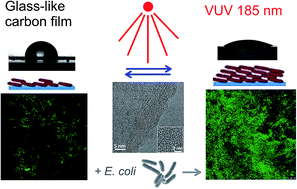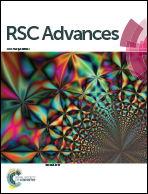Microbial colonisation of transparent glass-like carbon films triggered by a reversible radiation-induced hydrophobic to hydrophilic transition†
Abstract
We report a reversible wettability hydrophobic to hydrophilic transition in transparent glass-like carbon films under ultraviolet irradiation when the source emitted in the vacuum ultraviolet. The transition occurred at doses below 5 J cm−2 for devices emitting at 185 nm and was absent when using a 266 nm monochromatic laser source. Hydrophilicity, measured as the water contact angle, was higher when the films were irradiated in air with high relative humidity. Sample hydrophobicity was almost entirely restored over the following 24 h and was completely restored to the initial level when samples were stored for sufficient time under ambient conditions. Our observations were consistent with a transition caused by the dissociative adsorption of water molecules leading to the formation of polar surface groups. Over the few hours in which the surface remained hydrophilic under ambient conditions, a rapid colonisation with Escherichia coli took place with extensive biofilm formation. The percent surface colonised increased from 1.30% ± 0.4% to a maximum of 51.0% ± 2.7% for carbon films irradiated in dry air. Irradiation in the presence of water vapour led to surfaces which were more hydrophilic, but less prone to bacterial adhesion. Bacterial colonisation was favoured in films with intermediate hydrophilicity irrespective of the surface charge, measured as the zeta potential. Our study demonstrates that vacuum ultraviolet irradiation induces a wettability transition in glass-like carbon films, and that a relatively short ultraviolet dose of 185 nm irradiation renders their surfaces highly biocompatible.


 Please wait while we load your content...
Please wait while we load your content...